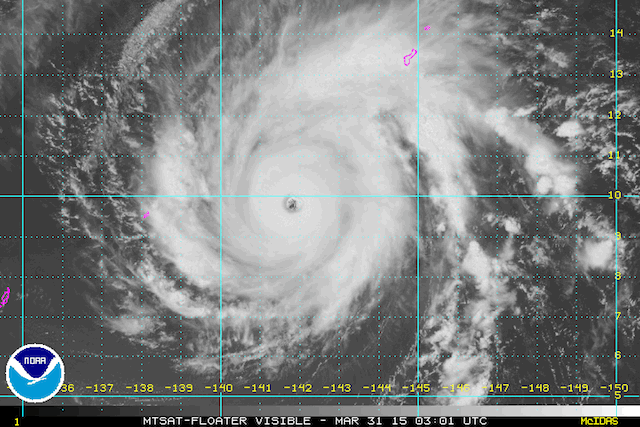SUMMARY
This is AI generated summarization, which may have errors. For context, always refer to the full article.

HAGATNA, Guam, USA (UPDATED) – Meteorologists warned Tuesday, March 31, that a storm reported to have left several casualties and severe damage in Micronesia was building into a super-typhoon as it swept across the central Pacific towards the Yap group of islands.
The island of Chuuk, part of the Federated States of Micronesia (FSM), received a direct hit late on Sunday, March 29, from Typhoon Maysak and the Yap group was next in its path.
“Chuuk was devastated,” lawyer Kembo Mida said in an email to the Ayuda Foundation relief organization which is based in Guam about 1,000 kilometers (600 miles) away.
“Houses were blown away and trees snapped in half. It was very dangerous and scary… a ship sank too.”
The Pacific News Center in Guam said FSM public information officer Marz Akapito “is reporting that five people have died in Chuuk state due to typhoon Maysak”.
The consul-general for FSM based in Guam, Robert Ruecho, told Agence France-Presse he had heard various casualty counts of one and later five, but “cannot confirm anything right now”.
Maysak was expected to have intensified to a maximum Category 5 storm by the time it hit Yap early Wednesday, April 1.
Neville Koop, a meteorologist with Fiji’s Na Draki weather service, said at its peak it would have winds of 270 kilometers per hour (168 miles per hour) with gusts up to 340kph.
“This typhoon will be very destructive,” Koop told Agence France-Presse. “At its peak Typhoon Maysak will be as strong as Cyclone Pam.”
Severe Tropical Cyclone Pam slammed into Vanuatu over two weeks ago, causing widespread damage and leaving 11 people dead in the South Pacific nation.
The director of the FSM National Emergency Management Office, Andrew Yatilman, told Radio New Zealand that Typhoon Maysak scored a direct hit on the most populated area of Chuuk, which is home to nearly 50,000 people.
“Residences (had) their roofs completely torn off, and so whoever was staying in those will have to be accommodated either by relatives or in public shelters that have been set up by the government,” he said.
“Most people are all right, we understand that there may have been a few casualties; between four and five that we know so far.”
Ruecho, the consul-general, told the Marianas Variety newspaper in Guam he had not been able to make contact with people in Chuuk.
“I haven’t been able to speak with the governor,” Ruecho said. “The phone lines have been difficult today, power is down and so my information is second hand from the (FSM) capital in Pohnpei.
“Lots of flooding and many of the roofs… we heard they were torn off many of the residences and buildings – maybe 80 to 90% of homes.”
In 2002 heavy rain from Tropical Storm Chataan triggered several landslides that killed 47 people in Chuuk’s deadliest weather disaster.
The Philippine state weather forecaster said it was too early to say if the latest typhoon would affect the country, but it would reassess the situation when the storm entered its area of responsibility on Wednesday or Thursday, April 2. (READ: Typhoon Maysak intensifies)
The Philippines is still recovering from Super Typhoon Haiyan which struck in November 2013, leaving more than 7,350 people dead or missing. – Rappler.com
Add a comment
How does this make you feel?


![[In This Economy] Can the PH become an upper-middle income country within this lifetime?](https://www.rappler.com/tachyon/2024/04/tl-ph-upper-income-country-04052024.jpg?resize=257%2C257&crop=295px%2C0px%2C720px%2C720px)


There are no comments yet. Add your comment to start the conversation.